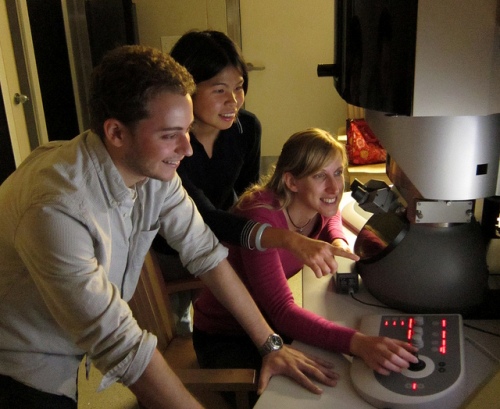An engineering team comprising Jennifer Dionne and Jonathan Scholl from the Stanford School of Engineering has investigated plasmon resonances of single metal particles that have a diameter of down to 1 nm. The research study will be reported in the journal, Nature.
 Stanford engineering researchers Jonathan Scholl, Ai Leen Koh and assistant professor Jennifer Dionne at the controls of the powerful Titan environmental scanning transmission electron microscope (E-STEM) installed recently at Stanford's Center for Nanoscale Science and Engineering. Photo: Andrea Baldi/Jennifer Dionne | Stanford University
Stanford engineering researchers Jonathan Scholl, Ai Leen Koh and assistant professor Jennifer Dionne at the controls of the powerful Titan environmental scanning transmission electron microscope (E-STEM) installed recently at Stanford's Center for Nanoscale Science and Engineering. Photo: Andrea Baldi/Jennifer Dionne | Stanford University
The study findings have extended the boundaries of the plasmonics field to better understand catalytic processes, including quantum computing, cancer research and treatment and artificial photosynthesis. Dionne explained that researchers are not able to reap the benefits of electronic and optical properties of these nanoparticles due to inadequate knowledge of the science. This paper lays the groundwork for new areas of nanotechnology entering the 100 to10000-atom size.
According to the researchers, like nanoparticles, plasmons can drive other major physical properties when they are confined in ultra-small spaces. This phenomenon is called as quantum confinement, which can control the optical and electrical response of a particle based on its size and shape. This study enables researchers to directly correlate the plasmon resonances of a quantum-sized plasmonic particle with its size and shape, for the first time.
Dionne informed that this new understanding may be helpful in building innovative photonic or electronic devices around plasmons’ excitation and detection in quantum-sized particles. It opens opportunities in therapeutics, bio-imaging, quantum optics and catalysis.
The researchers used the powerful environmental scanning transmission electron microscope (E-STEM), deployed recently at the Center for Nanoscale Science and Engineering of Stanford University, and electron energy-loss spectroscopy (EELS) to identify the geometry and behavior of single nanoparticles. The combination of STEM and EELS allowed the researchers to directly study the quantum plasmon resonances of the particles.
Scholl stated that in due course, this technique may be used to observe reactions in progress to improve them. The researchers developed an analytical model using quantum mechanical principles to describe the physics of their findings. This versatile model paves the way to several scientific developments.